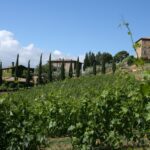Halfway up the southern slopes of Mount Cetona stands Palazzone, a hamlet of houses, probably originated on the road coming from Piazze heading for Fabro, a secondary route of the ancient Roman Via Cassia on the Orvieto - Chiusi section.
Historical outline
The historian Ripetti thinks Palazzone is "that villa or palazzo of S. Pellegrino near Fighine" in which the judicial decree of the Marquis Gottifredo was published in May 1058. However the name Stabbiano, belonging to the hamlet of Palazzone, would suggest that it was a place for changing horses.
It is interesting to note that in several places the old pontifical - grand ducal boundary is indicated by stone boundary posts, which even today mark the boundary between Tuscany and Umbria.
The village has archaeological remains and marine deposits belonging to the Pliocene age but despite the rocky subsoil, these slopes are rich in vines and vegetation, with woods of various species of oak and, in the undergrowth, broom and brambles.
Visiting the village.
Square of Il Pozzo in Palazzone with its barVisit the hamlet which is still intact and spreads out from the delightful Piazzetta del Pozzo, named after the public well. As in many important town centers it represented the fulcrum of the community. Here, in Pertini Square, village life has its source. During the year there are fixed dates such as the Wine Festival (July), Ferragosto (15th of August) and many other occasions when the village comes alive and everyone prepares willingly for the celebrations. The inhabitants are always ready and happy to welcome and involve short-stay visitors in local life.
In the center of the village there's a bar wehre you will always find someone to join you in a hand of cards and you'll also find a few well-stocked shops selling food and local products. You can also use the mini-football field and tennis court a short walk from the centre. Don't miss the fine view from the Church of Santa Maria Assunta, with three naves in Baroque style, overlooking Palazzone.


